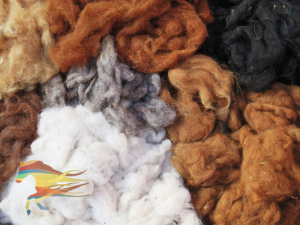

Wool and fibre businesses come in many forms, from sheep farmers who simply sell raw wool, to fibre artists and indie-dyers who produce complex fibre and wool products. Creating a viable wool or fibre business is reliant on having a clear and effective marketing strategy, and the crafting industry is often a close-knit community who benefit from niched marketing strategy. This is where email marketing can be extremely successful.
For sheep farmers, a wool business can be an effective farm diversification for adding value to something that is often a bi-product. Wool businesses are useful for bringing in additional income on a smaller scale and tend to work well alongside a wider farm business strategy or even as a way to make money from your smallholding.
To read more about how a wool or fibre business could benefit your farm business, check out this blog
 Why should you consider using email marketing?
Why should you consider using email marketing?When considering marketing channels for your wool business, you may end up focusing on social media platforms and forget to consider alternative channels of communication. This is very common in most small businesses today, as they see social media as the most important marketing channel. However, there are many other marketing channels that can be overlooked despite their potential value. One such option is email marketing.
Email marketing was once a very popular marketing channel and is still used successfully by many businesses, but the increasing pressure of GDPR compliance and ever stronger junk/spam filters mean that many small businesses tend to avoid email marketing. This doesn’t mean email marketing doesn’t have value in your wool business, but its role must be carefully considered, and email marketing should be used in a targeted way rather than the more traditional blanket approach.
To have a successful email marketing strategy, you need to ensure that you can build a community that will engage with your emails and regularly open them. Your email marketing should, at its heart, be a bit like a magazine or newsletter that adds value for the reader as well as promoting your products.
For more ideas on planning your marketing strategy for a wool business, check out this blog
To create your community, you need to gather subscribers. This is the part of email marketing that most small businesses find the most difficult and the part that tends to put them off using email marketing.
Ideally, you need to be able to capture customers’ details at every purchase. If you take orders in cash at events, this can be nearly impossible, but for most wool and fibre businesses, online orders and card transactions should provide a wealth of customer data to use in marketing.
You will need to consider how you remain compliant with data protection laws such as GDPR. If you are a member of FSB, they can provide advice on this, and we would also recommend further reading through the ICO website, which oversees data protection concerns for the government.
reading through the ICO website, which oversees data protection concerns for the government.
Broadly speaking, there are two main routes to being able to contact someone. Firstly, opting in, which has to be an informed decision by the individual to agree to be contacted by the business. You can get this through a tick box at purchase, a sign-up form, or in a follow-up email. Secondly, you can contact someone on a lawful/reasonable basis. For this, the person doesn’t have to have opted in, but there are limits to the type/quantity of emails you can send, and it’s generally a greyer area in terms of compliance.
The lawful basis available to your wool business will depend on who you are contacting, where you got their information, and why you are contacting them. The most common reason for your wool business is likely to be “current customer”. If the individual has purchased from you in the last 2 years and has provided their email address, and has not specifically opted out of being contacted, then you can contact them under this lawful basis. However, once two years have lapsed since their last purchase, you must stop. Ideally, during this time they will have purchased again to reset the time limit, or you will have been able to get to them to opt-in through a link or similar.
As mentioned above, to get the best out of email marketing, you need to make your audience feel like a community and feel that your emails offer them enough value to encourage them to open and read the email. Adding value can come in many forms, such as:
If you are new email marketing, it can seem daunting to plan and write an email campaign from scratch. To get you started, consider planning features and the layout first, then worry about the content. For example, you might decide to include the following sections:
These sections should work for most wool businesses, but you can also adjust them to create your own template that you can follow each time you prepare an email campaign. This will give you some structure to fall back on rather than feeling like you are starting from scratch each time.
For topic and blog ideas for your wool business, check out this blog
 Email marketing works best when your audience feel like they are treated as VIPs. They will also be more likely to engage with personalised emails, or at least those that feel personalised and relevant to them.
Email marketing works best when your audience feel like they are treated as VIPs. They will also be more likely to engage with personalised emails, or at least those that feel personalised and relevant to them.
Ideally, you want to ensure you can record as much data about each contact’s preferences as possible. For example, if you are a yarn business that produces yarns in different fibres, try to record which fibre each contact has a preference for. There is no point in marketing a new wool yarn to a contact who is allergic to wool, for example.
The level of data you have will develop over time, and you can take opportunities to review and improve data by asking contacts to complete surveys or by tracking their purchases, amongst other options. This could include periodically including a small “preferences” section on the end of your email in the “engagement” section if using the above suggested layout. This could ask them to indicate the type of products they are interested in and what they use your product for. For example, are they a knitter or a crocheter?
When considering your email marketing strategy, consider what you want each email to achieve. Your regular newsletter style email should be about community building and engagement rather than direct selling. But you may also choose to intersect these emails with more sales focused emails that are sent to a specific segment of your audience. For example, an offer on a new product release for those who have bought that type of product before or who have been the ones to vote on it if you have offered this previously.
Having the data about each audience member and their buying behaviours also allows you to cross- or up-sell these customers. For example, if you know a customer has purchased a starter kit or similar entry-level product previously, consider sending them a follow-up email with an offer for the next logical purchase. If someone has purchased a starter felting kit, you could send an offer for a larger order of fibre for felting approximately 2–3 weeks after when they have had a chance to use the starter kit and get hooked.
Making your customers feel valued increases brand loyalty and encourages them to promote you to others. This in turn brings in further income, but it is harder to track these increases as a clear cause and effect.
Cross- and up-selling are easier for you to track and allow you to increase the value of each customer. This includes re-engaging customers who have not purchased for some time.
We often get asked about choosing the right software for email marketing, and this is a tricky thing to recommend without knowing the skill set within a business and the needs of that business. For ideas and advice, you could check out this blog
We do offer email marketing training as part of Flame’s membership package, and also offer done-for-you email marketing as part of our Bespoke and Firestarter packages.